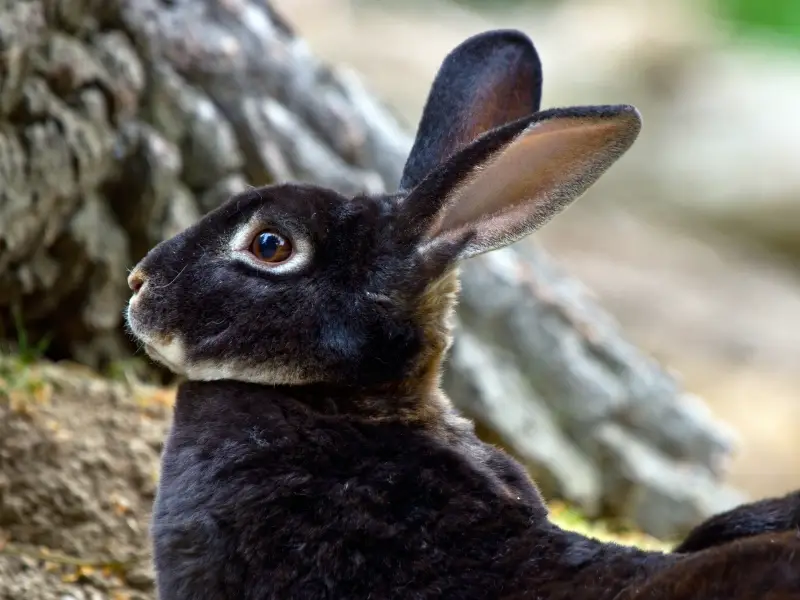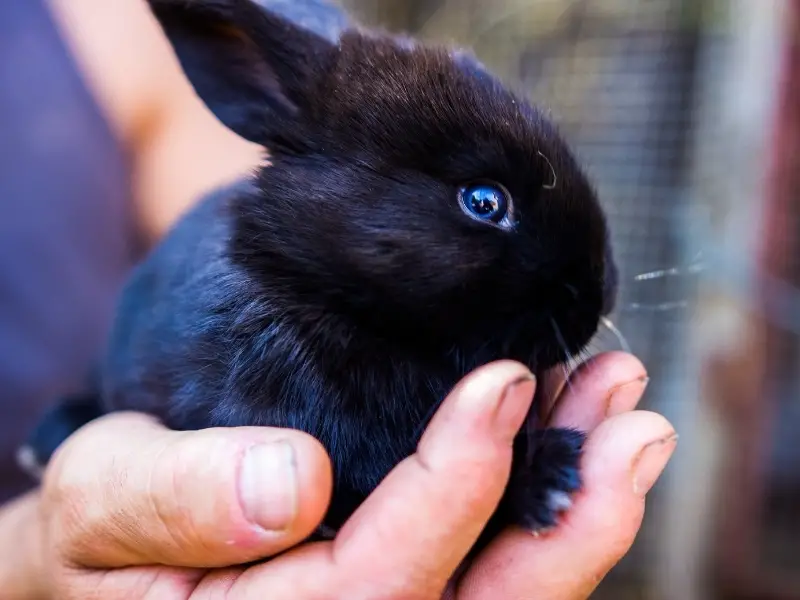The Havana rabbit is a medium-sized breed that originated in the Netherlands. Best known for its glossy and soft chocolate coat, the Havana rabbit breed is fairly easy to care for and maintain.
But do Havana rabbits shed? Havana rabbits have short and soft flyback fur that is easy to groom and maintain. These medium-sized rabbits shed minimally throughout the year, but they go through the molting season. During spring, your Havana rabbit will shed more than usual and you’ll need to brush it twice a week.
In this article, we’ll tell you more about the Havana rabbit, including its characteristics, temperament, dietary needs, and more. Keep on reading to find out if this cute and mellow rabbit can be the perfect pet bunny for your family.
What Is a Havana Rabbit?
Despite what their name suggests, the Havana rabbit breed hasn’t originated in Cuba. Havana rabbits are primarily bred as show rabbits, but they are also popular pet rabbits due to their calm and affectionate nature.
Havana Rabbit History and Origin
Havana rabbit is a breed of domestic rabbit that originated in the Netherlands. This rabbit breed is the happy result of a chance mating! The first-ever Havana rabbit was born in a litter of a Dutch doe in the late 1800s.
The bunny’s striking deep brown coloration spurred breeders to create a new rabbit breed. The new breed of rabbit got the name “Havana” because their chocolate brown coat resembles the color of Cuban cigars that are found in the city of Havana.
Havana rabbits made their way to the United States in 1916, where they were recognized by the American Rabbit Breeders Association the same year. Nicknamed the “Mink of the Fancy” this breed is now recognized in five different colors (source).
Havana Rabbit Characteristics

The Havana rabbit is neither a dwarf nor a standard breed, and they have short, rounded bodies. The top line should form a half-circle that rises over the hips right before or down to the tail.
Havana rabbits have short straight legs with dark-colored toenails that match their chocolate coats. When it comes to facial features, these bunnies have short heads, medium-sized eyes, full cheeks, and short ears that are spaced close together.
Size, Weight, Shape
The Havana is a medium-sized rabbit breed with a compact body type. They usually weigh between 4.5 and 6.5 pounds, and shouldn’t be any heavier.
Color Varieties
Originally, the Havana rabbit breed only came in rich chocolate color. However, breeders developed new color types over the years. The Havana rabbit now comes in five colors, including chocolate, blue, black, and broken.
The chocolate-colored variety was recognized in 1916 by the American Rabbit Breeders Association. The blue Havana rabbit was recognized in 1965 and the black Havana rabbit was recognized in 1980.
The broken-colored Havana rabbit is the newest addition, recognized in 2008 and best described as a mix of colors that look like a Dalmatian dog.
Coat
This rabbit breed has a soft and short flyback fur that doesn’t shed much and doesn’t need too much maintenance to stay in perfect condition.
To keep the shedding to a minimum, brush your Havana rabbit, once a week. Besides removing loose hair and keeping your bunny’s coat clean and shiny, regular grooming can also lower the risk of GI stasis.
Like all other rabbit breeds, the Havana rabbit will go through a molting season and will shed more than usual during spring. At this time, brush your rabbit twice a week using a slicker brush to reduce the amount of loose hair.
Lifespan
The Havana rabbit has an average lifespan of five to eight years. With that said, it’s not uncommon for these bunnies to live longer when they are properly cared for and taken to regular veterinary checkups.
Temperament
Although primarily bred as show rabbits, Havana bunnies make fantastic pets and furry companions. These gorgeous bunnies easily bond with their families, given the chance, and make sweet and affectionate pets.
Havana rabbits aren’t the most energetic rabbit breed, but are capable of playing and running indoors, and may even surprise you with an occasional mid-air hop.
When playing with your Havana rabbit, you’ll notice that your pet bunny is particularly fond of ear and head scratches, and gentle back petting. Sweet, mellow, and friendly by nature they like to interact with their owners and will soon become a full-fledged member of your family.
Due to their medium size, sweet, and not overly energetic nature, Havana rabbits make wonderful pets to families with children of any age. These bunnies aren’t known to be aggressive or hostile and will enjoy spending time with kids who know how to handle a rabbit properly.
Like all other rabbits, the Havana rabbit can become bored and frustrated if not provided with adequate toys to play with (source).
Some rabbits are perfectly content playing with simple things, such as a toilet paper roll, while others need more elaborate toys to stay entertained and mentally stimulated. It’s up to you to discover what works best for your Havana rabbit based on its personality.
While rabbits aren’t the easiest pets to train, you can still teach your Havana rabbit to use a litter box. Litter training a rabbit takes time and patience, so don’t expect to see any major changes in your bunny’s toilet habits overnight.
Most rabbit owners find that placing several litter boxes around the house gives the best results and makes training a lot easier. By giving your Havana rabbit several litter boxes to choose from you are lowering the chance of them having an accident while looking for a litter box.
Havana Rabbit Care
Like any other breed of rabbit, the Havana rabbit requires proper care and a lot of attention to stay healthy and thrive. Before you welcome this gorgeous bunny into your home, make sure that you’ll be able to care for it properly.
Housing
The great thing about Havana rabbits is that they generally do well whether they are living indoors or outdoors. To stay happy and healthy your bunny will need to spend plenty of time outside its enclosure to stretch its legs and explore.
If you decide to keep your Havana rabbit outdoors, choose a wooden or wire enclosure and make sure that it’s raised from the ground.
Indoor enclosures should be made of strong wire and have a plastic bottom that won’t chafe your rabbit’s feet and cause sore hocks.
Line the enclosure with rabbit-safe bedding such as hay, wood pellets, or shredded paper. The bedding should be spot cleaned every day and removed entirely once a week to maintain hygiene inside the enclosure.
Diet
Like any other breed of rabbit, the Havana rabbit requires a diet that consists of at least 70% hay. The rest of their diet should be made of equal parts fruits, vegetables, and rabbit pellets.
Be mindful of what types of fruits and vegetables you are offering to your rabbit, as not all produce is safe for bunnies to eat. Iceberg lettuce, for example, doesn’t offer any nutritional value but contains chemicals similar to laudanum which can be harmful to your rabbit in larger quantities.
Besides a varied and balanced diet, your Havana rabbit needs unrestricted access to clean and fresh water at all times.
Health
The Havana rabbit doesn’t suffer from any breed-specific health problems and is considered a generally healthy rabbit. However, like all other bunnies, Havana too can be affected by common rabbit diseases.
Overgrown teeth are the most common health problem most rabbits face, and is directly linked with their diet. A rabbit’s teeth never stop growing and can grow into their jaws and faces if a bunny isn’t eating enough hay.
Chewing on hay naturally wears the teeth down, keeping them at a normal length and preventing painful dental problems. To prevent overgrown teeth feed your Havana rabbit with at least 70% hay, as chewing on it will naturally file down their teeth.
If you decide to keep your rabbits outdoors, know that they will be more susceptible to flystrike. This is an extremely painful and dangerous condition that happens when flies lay eggs in a rabbit’s fur near dirty areas.
When eggs start to hatch they start eating your rabbit inside out as a way of sustaining themselves. If not caught in time, flystrike is a potentially lethal condition! So, keep a close eye on your bunny and take them to the vet on the first sign of disease.
Havana Rabbit Price
Havana rabbits on average cost between $20 and $100. Pet quality rabbits are usually on the lower end of the price range, while show quality rabbits cost more depending on their coat color and pedigree.
Conclusion
The Havana rabbit dominates rabbit shows but is also a popular pet rabbit. Best known for their striking chocolate-colored coat, these bunnies make fantastic pets to people of all ages and families with children.
Affectionate, sweet, and calm, the Havana bunny likes to spend time with its owners and forms close bonds with the entire family. If you decide to welcome this bunny into your home, you’ll get a loving, cuddly, and gorgeous companion.
Related Articles:

